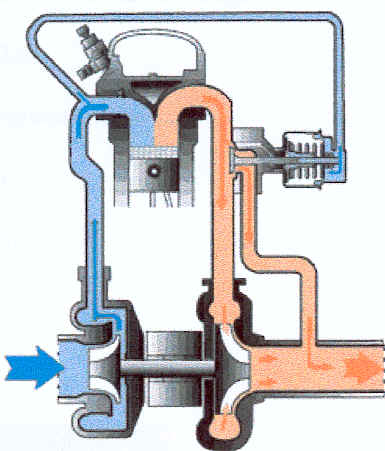Wastegates
Exhaust gas from the engine push the blades on the hot side of the turbo, in turn making boost on the compressor (cold side). A wastegate plumbs in between the exhaust gas coming out of the engine and the exhaust gas pushing on the fins of the hot side. The wastegate gets it's vacuum/boost "signal" from the intake manifold via a vacuum line (this is where people install boost controllers, to interfere with the "signal" to get desired boost levels). A wastegate works on a principle of pressure differential; once it sees the right amount of pressure from the intake, the pressure differential will change and the wastegate opens accordingly. This has the effect of limiting the exhaust gas push on the turbine. If the boost signal falls back below where the wastegate is mechanically set to maintain, then the wastegate closes back to allow more of a push on the turbine fins to occur.
There are two basic types of wastegates: internal and external. An external wastegate is usually mounted right on the manifold so as to alleviate the pressure of the exhaust gas. An internal wastegate is mounted within the hot side turbine housing. It actuates a hole that releases the exhaust gas into the exhaust pipe instead of letting it flow to the turbine.
If a wastegate is not present, malfunctioning, or welded shut, and you keep the foot on the gas, the turbo and engine will boost as much pressure as it can create/handle (pop, boom, sputter, knock, thrash goes the engine).
Blow Off Valves
A blow off valve (BOV) or bypass valve works only within the actual intercooler piping / intake track. When a turbo creates pressure, it is sent through the throttle body and into the intake manifold. Once you let off the gas, the throttle body snaps shut and the boost that is coming up the piping slams into the throttle body. The pressurized air has no where to go, so it heads right back to the fins of the compressor on the turbo (this is that "chu chu chu chu" sound you hear as the air bounces back and forth with an improperly tuned BOV). The BOV works on a very similar design as the wastegate with pressure differentials and the such. The BOV will give the air a path to escape through so that it doesn't bounce around on the fins of the delicate turbo.
A BOV can be vented to the atmosphere, or it can be recirculated back into the intake (after the AFM, but before the turbo). When it vents to the atmosphere, you are loosing metered and accounted for air, so the engine is running really rich immediately after a BOV releases. For a stock car, the best thing to do is to reroute the BOV back into the intake. It does muffle the sound of the BOV a bit, but it is better for the engine / tuning sake.
A BOV doesn't actually regulate any sort of boost level (as long as it is working correctly); only the wastegate and your foot can really control boost (when everything is working properly).
Some pics:
This is a diagram of an external wastegate that is routed back into the exhaust pipe:
A real picture of the above setup:
This is the backside of the hot side / exhaust turbine of the ct26 with an internal wastegate (notice the trap door thing on the right):
The internal wastegate is actuated by the round thing on the right side of the turbo via a mechanical steel rod:
This is a BOV that is venting to the atmosphere (on the bottom of the intercooler pipe):
This is a BOV that has been recirculated back into the intake:






